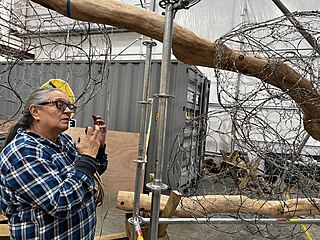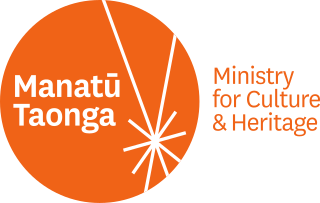Related Research Articles

Henrietta Catherine Angus, known as Rita Cook early in her career, was a New Zealand painter who, alongside Colin McCahon and Toss Woollaston, is regarded as one of the leading figures in twentieth-century New Zealand art. She worked primarily in oil and watercolour, and became known for her portraits and landscapes.

Shona Rapira Davies is a New Zealand sculptor and painter of Ngātiwai ki Aotea tribal descent currently residing in Wellington, New Zealand.

The Ministry for Culture and Heritage is the department of the New Zealand Government responsible for supporting the arts, culture, built heritage, sport and recreation, and broadcasting sectors in New Zealand and advising government on such.
Erenora Puketapu-Hetet was a noted New Zealand weaver and author. A key figure in the Māori cultural renaissance, she helped change perceptions of Māori weaving/raranga from craft to internationally recognised art.
Patricia Charlotte Perrin was a New Zealand potter. She was born in Auckland, New Zealand on 11 July 1921 and died at Auckland Hospital on 12 November 1988.

Hūria Mātenga was a New Zealand tribal leader and landowner. Of Māori descent, she identified with the Ngāti Tama, Ngāti Toa and Te Āti Awa iwi. She was born in Whakapuaka, Nelson, New Zealand in about 1842.

Hester Maclean, was an Australian-born nurse, hospital matron, nursing administrator, editor and writer who spent most of her career in New Zealand. She served in the First World War as the founding Matron-in-Chief of the New Zealand Army Nursing Service, and was one of the first nurses to be awarded the Florence Nightingale Medal.

Averil Margaret Lysaght was a New Zealand biologist, science historian and artist, best known for her scholarly work on Joseph Banks.
Mary Ruddock was a New Zealand businesswoman who ran a dressmaking business in Wellington from the 1930s to the 1960s.
Lily Lind was a nurse from New Zealand who served in France in World War I.
Marion Elizabeth Tylee was a New Zealand artist.

Helen Stewart was a New Zealand artist.
Elise Constance Mourant was a New Zealand artist. Works by Mourant are held in the collection of the Museum of New Zealand Te Papa Tongarewa.
Mary Elizabeth Greenwood was a New Zealand photographer. She was an early promoter of the autochrome photographic process in New Zealand. Her work is held by the Museum of New Zealand Te Papa Tongarewa and by the National Library of New Zealand.

Lindah Aaron Lepou is a New Zealand-Samoan fashion designer. Her work is included in the permanent collection of Museum of New Zealand Te Papa Tongarewa.
Gladys Mary Goodall was a New Zealand photographer whose work was used for scenic postcards of the country. Her photographs are held in the collection of Museum of New Zealand Te Papa Tongarewa and the National Library of New Zealand.

Marion Queenie Kirker (1881–1971) was a New Zealand photographer. Her work is held in the collection of the Museum of New Zealand Te Papa Tongarewa.
Lorna Ellis née Trengrove was a New Zealand sculptor and ceramist. Her works are held in the collection of Museum of New Zealand Te Papa Tongarewa.

Victoria Alexandrina Muriel May, Baroness Plunket was a nursing association founder and vicereine.

Mrs Humphrey Devereux is a 1771 oil painting on canvas by the Anglo-American painter John Singleton Copley. It is part of the international painting collection of the Museum of New Zealand Te Papa Tongarewa.
References
- ↑ "New Zealand Army Nursing Service in the First World War - New Zealand Army Nursing Service | NZHistory, New Zealand history online". nzhistory.govt.nz. Retrieved 10 May 2018.
- 1 2 3 "Collections Online - Museum of New Zealand Te Papa Tongarewa". collections.tepapa.govt.nz. Retrieved 10 May 2018.
- 1 2 "Collections Online - Museum of New Zealand Te Papa Tongarewa". collections.tepapa.govt.nz. Retrieved 10 May 2018.
- 1 2 3 4 5 6 7 8 9 "'Actively engaged, often under fire' - Two New Zealand Nurses in the French Flag Nursing Corps | WW100 New Zealand". ww100.govt.nz. Retrieved 2 September 2017.
- ↑ Auckland Museum. "Margaret Hitchcock" . Retrieved 10 May 2018.